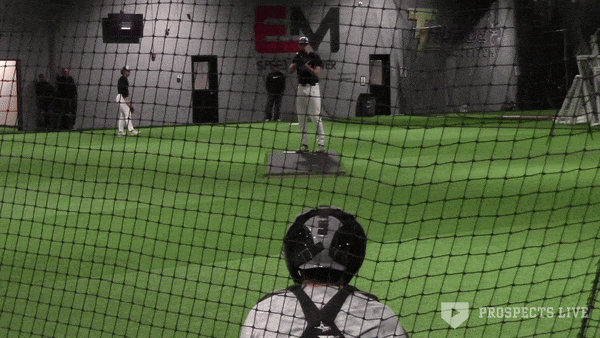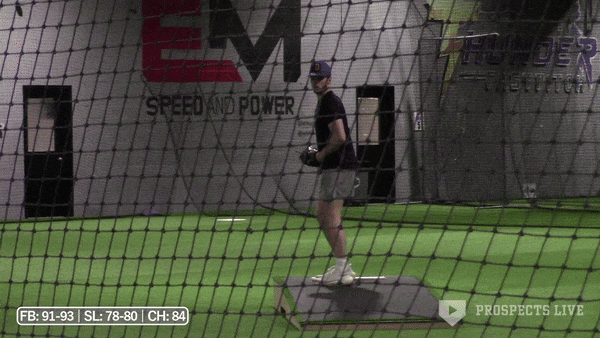Over the past month and a half, I’ve been traveling all over eastern Pennsylvania watching the best of what prep baseball has to offer in this area. In this article, I’m going to do my best to describe my favorite players that I’ve seen so far.
Tegan Kuhns (RHP, Gettysburg Area - Tennessee)
Tegan Kuhns, member of the 2023 Team USA 18U team and our number 55 draft prospect for 2024, has solidified himself as the top prep draft prospect in PA. His arsenal which includes a fastball that reaches 96 mph, a sharp upper 70s slider, and a mid 80s splitter is built to make him a swing-and-miss machine. Standing at 6’3, 177lbs, he has room to fill out and increase his velocity even more.
Kuhns is a superb athlete on the mound. Combo his athleticism with his slender build, and you have the perfect example of projection. His long arms plus extension and his ability to elevate his fastball make that far and away his best strikeout pitch. His breaking ball is more of a true slider and he can throw it in any count. His release makes it look just like his fastball and it flies across the zone hard, generating a ton of chases. The splitter may be my favorite pitch of his. It’s hard and has the depth and arm-side movement that will get him plenty of ground balls and out of some tough situations.
He will turn 19 a couple of months before the draft, however, I don’t think that will affect his stock too much. There’s a lot to like about Kuhns and he has tons of room to grow and improve. I won’t be shocked if we hear his name called in the first couple of days of the draft.
Chase Harlan (3B, Central Bucks East - Clemson)
Chase Harlan, our number 159 draft prospect for 2024, is a strong and physical third-baseman. When I saw Harlan early into the spring, I immediately got the impression that he had the capabilities to stick at third base. He has good size, a plus arm, and a solid glove at the hot corner. Athletically, he has the quickness and reactions to stick at the position as well. Given his speed and arm, I do see a possibility that he could have a future at one of the corner outfield spots however, I think he will do just fine at third base.
At the plate this spring, Harlan has shown off his bat speed and power to all fields. When I saw him, he drove a double into the right-center field gap and the next at-bat was a double to left. Every at-bat I saw (outside of the intentional walks), Harlan put the bat on the ball in a productive way. Early on, there was both some swing-and-miss and some chase to his game, but I’ve been hearing that he has cleaned a lot of that up so, I am looking forward to checking him out again this spring.
Tague Davis (1B/LHP, Malvern Prep - Louisville)
Tague Davis, like the others here, has put on a strong performance so far this spring. He has a pro-ready body at 6’3, 205 lbs. In the three games I’ve seen him play, he has shown off his power at the plate every time. While there is some swing and miss to his profile right now, each time I’ve seen him play he has made better and better contact quality. The combination of his size, bat speed, and bat path built for loft always makes him a threat to go yard every time he comes to the plate.
I finally had the chance to watch Davis pitch last week and he had a strong game overall. He located his fastball well at 87-89 mph and his big breaking slider at 75-77 mph. He also featured a very deceptive changeup that looked identical to his fastball, only about 6-8 mph slower. So far this spring, Davis’ fastball has consistently been a couple of ticks higher in velocity but, when I saw him, he commanded the zone well and was getting tons of weak contact without the higher velocity. Also, he limited baserunners well, allowing only three hits and one walk through six innings of work. One thing I was hoping to see from him was to reach back and try to blow one by the hitter, but I never saw it. That’s not a knock on Davis, he just never had to because he was doing such a good job at missing barrels already.
Davis not only has the prototypical size to play first base, but he also defends the position very well. He’s a physical defender, not afraid to put his body in front of the ball. He is also quick enough to make plays away from his body and handles tough throws from infielders with ease. I look forward to tracking his progress throughout the rest of the spring and seeing if he can improve his stock more than he already has.
Dylan Hansen (RHP, Downingtown East - Coastal Carolina)
Dylan Hansen was a very fun watch for me. He has a strong frame at 6’3, 215 lbs and puts every bit of it into his pitches. When I saw Hansen, he featured a 92-94 mph fastball with good life, a 77-80 mph slurvy breaking ball, and an 82-85 mph tumbling changeup. He elevates his fastball well and commands his off-speed with it, making it tough to put the barrel on the ball. His long arms and legs made his low-mid 90s fastball look much faster than it was. Hansen was in constant attack mode, not shying away from anyone who stepped in the box. There was a lot of effort in his delivery, causing him to tire out a little quicker than you would hope. By the fifth inning, his velocity had fallen by about five mph on his fastball. However, he was still able to strike out his last batter on a 93 mph fastball above the zone. The Coastal Carolina commit has shown that he has a strong foundation and has the stuff to build on and become an excellent pitcher at the next level.
Kross Howarth (INF/RHP, Perkiomen School - Tulane)
Kross Howarth is a primary pitcher who thrives on attacking the zone and getting swings and misses. This spring, he has featured an 88-92 mph fastball, a big sweeping 75-77 mph slider, and an 82-85 mph changeup. His fastball has some sinker action and he can run it inside to right-handed batters with conviction. He combos it well with the slider and changeup and he’s able to throw all three pitches in any count. The one concern I have with Howarth is that he hasn’t gained much velocity from a year ago and he is already 19 years old. With his 6’5” 200 lb frame though, there is still room to get stronger and gain velocity.
At the plate, Howarth has a long, powerful swing. He has a strong base that can generate a lot of power. I worry about his consistency in making good contact with the ball and the results he will get once he faces higher velocities at the next level. Defensively, he has bounced all around the infield this year. I feel that given his strong arm and glove, but lesser range, he is a prime candidate to play third base at the next level and I believe he will be able to do it well. Howarth always brings intensity every time he goes onto the field and he is looking to build on his already strong spring.
Evan Jones (RHP, Methacton - Wake Forest)
Evan Jones is the only 2025 graduate I am including in this article. He is a tall, lanky Wake Forest commit that features a 90-93 mph fastball, 80-82 mph slider, and an upper 70’s changeup. He only pitched two innings when I saw him early into the season, but he was impressive nonetheless. He really gets into his lower half during his delivery, generating his velocity from the ground up. He hides the ball well and has a low three-quarter slot with a good amount of arm-side run to his fastball. The slider stays in the zone for a long time, getting him a lot of chases with it. It didn’t take much for me to understand why Wake Forest likes him so much and he’s going to be a fun pitcher to track the rest of this year and next.
Nathan Arterbridge (C, St. George’s Tech - Missouri State)
While I know this is all about the Pennsylvania prospects, I do want to talk about the Deleware prep catcher, Nathan Arterbridge. I saw Arterbridge pretty early into the spring and his physicality immediately stood out to me. I had his pop time at 2.08 secs and he did an excellent job at blocking every pitch in the dirt. He has good size at 6’1, 205 lbs, and is an excellent mover behind the plate. He also has very strong hands and presents the ball well. I enjoyed watching him catch and I don’t feel that there is any concern about how he will handle catching higher velocities.
At the plate, Arterbridge has above-average bat speed and the game power plays as well. Like a lot of younger players, he has some swing-and-miss. Despite that, he was quite picky in the box, rarely expanding his zone. He limits his movement at the plate using a quiet load and a low step so that he’s always ready to attack when he gets the pitch he wants. I look forward to seeing how he performs the rest of the spring, at Missouri State, and on.
Twitter/X: @JakeBarg










